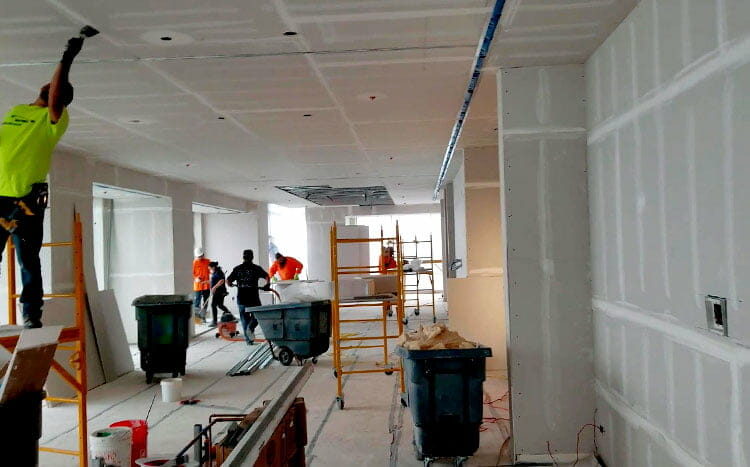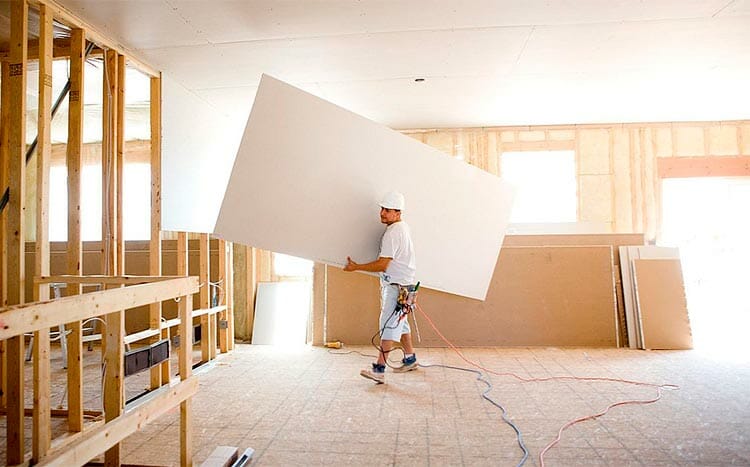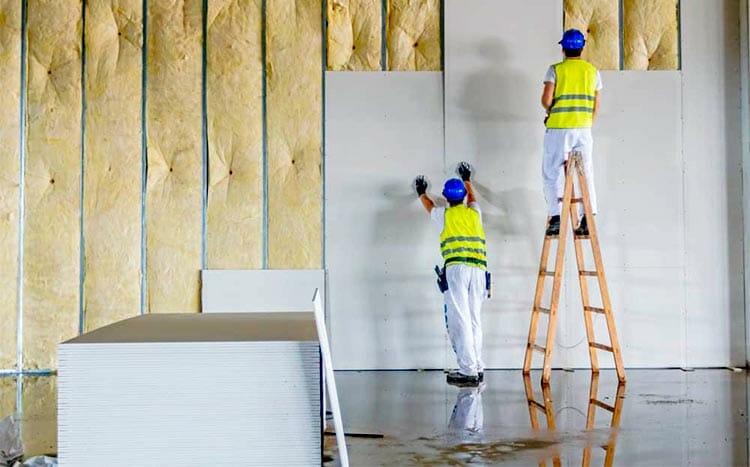When planning your home renovation, you’ve probably come across these two terms, drywall and sheetrock. Most contractors use the terms interchangeably, and this confuses many homeowners.
The truth is, the difference between these two construction materials is minute.
What is drywall?
Drywall is among the most common construction materials used when creating walls and ceilings. It’s derived from the compound, Calcium Sulfate Dihydrate, popularly known as Gypsum rock, sandwiched between two hard papers to form a thin sheet or board.
Once ready for installation, the drywall is attached to your home’s studs and wooden frames using nails and screws. It might also be combined with a joint compound to fill the seams left open by pieces of the drywall.
Drywall is popular because it’s lightweight, easy and fast to install and repair, and very strong.

What is sheetrock?
Sheetrock is merely a German brand of drywall that first hit the markets in early 1917. It’s manufactured by the US Gypsum Company and can be used for the same functions as regular drywall.
Sheetrock has become widely popular among contractors and homeowners mainly because it offers more features with its specialized drywall panels.
It also comes in different types of sheetrock drywall, which has led many to believe that sheetrock brings better quality.
But generally, the only difference between sheetrock and drywall is just the brand name (Sheetrock). Otherwise, they both refer to the same generic drywall.
What types of drywall and sheetrock are there?
There are several different types of drywall and sheetrock in the market, each different depending on its application and features. Among the most popular ones include:

Green board
Green board drywall is also known as moisture-resistant drywall. It comes in a green covering, which helps protect your walls and ceilings from mold and mildew infestation.
Its moisture-resistance means it is commonly used in high-humidity rooms like the bathroom, kitchen, and basement walls. On average, this board costs about 20% more than the regular drywall.
You might often hear other people refer to it as an indoor tile backer or cement board.
Eco-Friendly drywall
Environmentally friendly drywalls are also becoming more popular by the day. This drywall is manufactured using recycled industrial byproducts, making them earth-friendly and still strong enough for drywall.
To improve its resistance to mold, mildew, and termites, manufacturers mix the recycled byproducts with water and a filler.
Waste from agriculture, newspapers, among other industries, can also be recycled to make the drywall.
Paperless drywall
Paperless drywall is different from other drywall materials because it’s covered with fiberglass facings instead of paper. This protects the gypsum from mold and mildew attacks and also from rotting.
Paperless drywall offers better characteristics than regular drywall, and it’s relatively easier to work with.
You might also need to apply a joint compound to achieve a smooth finish.
Fireboard / Type X drywall
Even though most types of drywall are fire-resistant, there’s a special type of drywall that has been developed to achieve a high fire rating. This drywall is known as the fireboard, X board, or type X board.
It’s common in most commercial buildings, apartments, garages, and many housing units, as recommended by the state building code.
This drywall is usually thicker compared to other drywalls and contains numerous non-combustible fibers. Even so, the drywall isn’t fireproof and usually comes with an hour fire rating for the 5/8-inch board and a ½-hour rating for the ½ inch board for every layer.
This fire-resistant drywall costs about 10% more than regular drywall.
Sound-Proof drywall
Right from its name, soundproof drywall refers to a special type of drywall that dampens and absorbs sound noise and vibrations.
The drywall is pretty similar to the typical drywall, but comprises more wood fibers, gypsum, and polymers that increase the wall’s sound transmission class (STC). It also reduces sound transmission from one room to another.
This type of drywall is denser than most others making it harder to cut, and is about 400% more expensive than the standard drywall.
How thick is drywall?
Drywall comes in a variety of thicknesses, but the most common sizes are the ¼ inch, 3/8 inch, ½ inch, and the 5/8-inch drywall.
- The 1/4 inch drywall is the most budget-friendly option for homeowners. It’s commonly used over plastered surfaces and sometimes curved walls. It’s also very thin, and hence you’ll have to be careful with it to avoid breaking it.
- The 3/8-inch drywall is popularly used for repairs and fixing damaged drywall during remodeling projects. It particularly works best on drywall areas where the plaster has been damaged.
- 1/2-inch drywall is the most common drywall in use today. It’s very thick and dense, making it perfect for home walls and ceilings. Drywall of this size is used together with the wood and steel frame in many residential home projects.
- 5/8-inch drywall is the heaviest and thickest drywall available in the market. It’s popular in commercial buildings due to its fire-resistant and soundproof properties. It also offers good heat insulation and moisture-resistant characteristics. Expect to dig deep in your pockets for this.
This table shows price ranges for 4’ x 8’ drywall panels.
| Type | Price range |
|---|---|
| 1/4 inch | $10 - $12 |
| 5/8 inch | $14 - $20 |
| 3/4 inch | $20 - $35 |
Drywall vs. Sheetrock vs. Plaster
While there’s no difference (besides the naming) between drywall and sheetrock, plaster is a different material.
Plaster is mainly used for decorating, coating, and protecting a home’s inner walls and ceilings. It’s one of the earliest building materials to be used and results in a high-quality and long-lasting wall treatment.
Each of these three materials; drywall, sheetrock, and plaster, have their advantages and disadvantages. Carefully consider each before making your decision on the material you want to use.
Drywall
Advantages
- Faster and easier installation process compared to plaster
- Cost-effective and readily available
- More stable than plaster and very easy to repair
- It’s fire-resistant thanks to the gypsum element in its composition
- Leaves worksite clean since it doesn’t require water
- The drywall surface is uniform and very easy to paint
- Makes it easier to hang recessed lighting among other fixtures on your walls and ceilings.
- Drywall can be used for the construction of both regular walls and ceilings as well as a partition.
- Numerous drywall finishing options
Disadvantages
- It’s not resistant to water. It’s prone to water damage if installed in highly moist areas like the bathroom and kitchen and can easily attract mold and mildew growth.
- Drywall isn’t very durable compared to other materials. It’s not resistant to impact and easily gets damaged when installed in a high-traffic area.
- Installation requires a professional to ensure a high-quality finish and avoid issues with the joints and tapes later on.
- Drywall isn’t soundproof
- It can’t stand on its own and requires wooden or steel framings during the erection.
- It’s hard to recycle, and most waste drywall is thrown into landfills which isn’t healthy for the environment. Some drywall also emits poisonous Sulfur gas.
- Installation produces a lot of dust which easily spreads throughout the house.
Sheetrock
Advantages
- Good fire resistance owing to the crystallization water in the Gypsum
- Installation may only take a day which is faster than the installation time for plaster.
- Comes in many types and features to meet your renovation needs.
- Weighs less than other materials
- Most sheetrock brands are environmentally friendly and don’t emit Sulfur gas.
- Easily hangs on walls and offers good heat insulation
Disadvantages
- Like drywall, sheetrock is prone to water damage. The paper used gets moldy quickly on exposure to water, and the damage is imminent.
- A lot of wastage, about 17%, when cutting the material to fit different sizes.
- Low durability and doesn’t work effectively in high-traffic rooms.
- Inefficient soundproof characteristics
- More expensive than regular drywall
Plaster
Advantages
- More durable and long-lasting than most building materials
- Better soundproof properties than drywall and sheetrock due to their thickness
- More flexibility to work with other textures and materials, including drywall and sheetrock.
- Fire-resistant thanks to the lime plaster material
- Low shrinkage cracks during the installation
- Easier to clean than other materials
- Doesn’t allow mold and mildew to grow on it
- Higher-quality finishes and more elegant styles
Disadvantages
- Labor intensive. Plastering your walls and ceilings will demand about two to three coatings due to the porous nature of the material.
- It may be more costly than other materials since you’ll need to hire a skilled and trained professional to help with the job.
- Plaster is harder to repair once it cracks or crumbles. It requires a lot of work to cut and scrape off the affected parts and install the replacements.
- Plaster may change color as it gets older, meaning you may have to repaint the whole wall if you repair one area.
- Poor insulation properties which increase your overall energy bills.
Drywall vs. Sheetrock cost comparison
Sheetrock is generally more expensive than regular drywall. However, the cost of these products depends on the type and their sizes. Here are the approximate costs of different types of drywall:
Green board drywall – $14 to $18 per panel
Blue board drywall – $12 to $15 per panel
Fire-resistant drywall – $20 to $30 per panel
Purple board drywall – $15 to $60 per panel
These costs could be higher depending on the features you expect from your drywall. For instance, Paperless gypsum, moisture-resistant, or abuse-resistant drywall may cost you anywhere from $12 to $60 per panel.
The price comparison table below doesn’t cover the shipping costs or other materials you’ll need like tape, screws, and mud.
| Type | Drywall | Sheetrock |
|---|---|---|
| ¼ inch | $10 - $12 | $10 - $15 |
| ⅜ inch | $10 - $15 | $10 - $18 |
| ½ inch | $12 - $24 | $10 - $20 |
| ⅝ inch | $14 - $35 | $13 - $75 |
The cost to install both drywall and sheetrock ranges between $1 – $3 per square foot. It could be higher if there are additional services included, like removing your old drywall.
FAQ’s
Is it ok to put drywall over drywall?
It’ll depend on the state of the old drywall. If the old drywall is damaged or cracked, you can opt to cut out a drywall of the same size as the affected area and install it over that old drywall.
Putting drywall over the affected areas easily hides any flaws and imperfections. It can also be a good way to improve the soundproof properties of a room.
However, if the old drywall is too damaged, you’ll have to rip it apart and install a new layer.
Should drywall touch the floor?
No! During your drywall installation, you should leave about ½ inches between the drywall and the floor. This space is vital to facilitate expansion and contractions without cracking the drywall.
That space also prevents moisture from wicking into the drywall and attracts mold growth whenever there’s water damage in the room.
How much does a sheet of drywall weigh?
It depends on the size and thickness of the drywall. The bigger or thicker drywall is, the heavier it weighs. So, 5/8-inch drywall will be heavier than a ¼-inch wall, even if both have the same dimensions.
A 4’ x 8’ x ½ generally weighs around 52 pounds per sheet. A square foot of the same drywall weighs around 1.6 pounds.
A 4′ x 12′ x ½ inches weighs around 77 pounds per sheet. This equates to about 2.3 pounds per square foot.
Other factors that may influence the weight of the drywall include; the humidity levels, the type of drywall, e.g., green boards (moisture-resistant drywalls are usually heavier), the manufacturing location, and the drywall brand.
Should I drywall the ceiling or walls first?
The ceiling always comes first, then the walls. Adding drywall to the walls first before the ceiling can result in a situation where some of your drywalls are not supported along the edges.
By starting with the ceilings, you’ll be able to lift your drywall sheets to form tight joints and avoid gaps. It’s also much easier to work from the top down than vice versa.
Furthermore, drywalling the ceiling provides ample support and stability for the drywalls, especially if there are other floors in the building.








